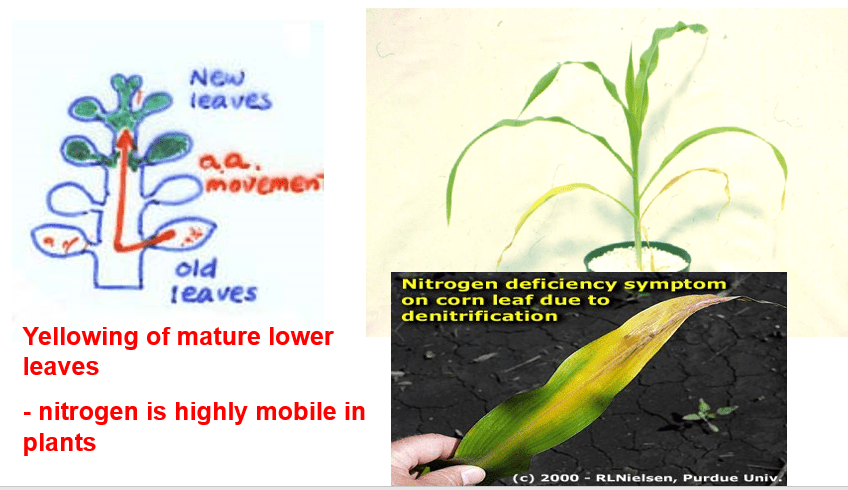Plant nutrition and root nodule development for nitrogen fixation (Lecture 13 & 14)
Objectives
1.Nutrient classification
2.Soil characteristics
3.Concepts of critical concentration
4.The role of function & mobility of the element in the development of mineral deficiency symptoms
5.Macronutrients: Functions; Deficiency & Toxicity Symptoms
1. Nutrient classification:
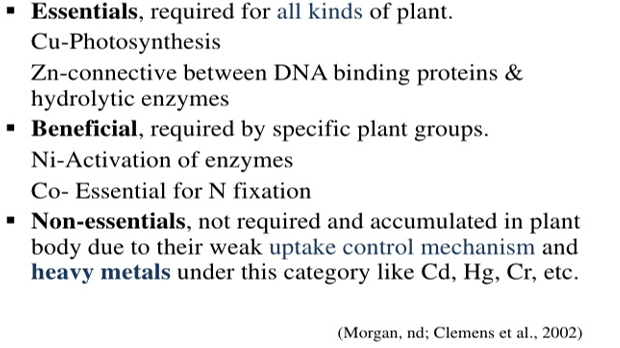
Primary: Nitrogen (N)
Phosphorus (P)
Potassium (K)
Secondary: Sulfur (S)
Calcium (Ca)
Iron (Fe)
Magnesium (Mg)
Micronutrients: Molybdenum (Mo)
Boron (B)
Copper (Cu)
Manganese (Mn)
Zinc (Zn)
Chlorine (Cl)
2. Soil Characteristics
Soil quality is a major determinant of plant distribution and growth Along with climate
The major factors determining whether particular plants can grow well in a certain location are the texture and composition of the soil
Texture…is the soil’s general structure (sandy, clay, sandy loam, silt etc)
Soil texture and soil structure are both unique properties of the soil that will have a profound effect on the behavior of soils, such as
vWater holding capacity
vNutrient retention and supply
vDrainage
vNutrient leaching
Soil texture has an important role in nutrient management because it influences nutrient retention.
For instance, finer textured soils tend to have greater ability to store soil nutrients.
Preferred soil texture for gardening/agriculture
Sandy loam is a type of soil used for gardening.
This soil type is normally made up of sand along with varying amounts of silt and clay.
Many people prefer sandy loam soil for their gardening because this type of soil normally allows for good drainage and leaching of nutrients.
Sand particles are often larger and more solid than other types of particles found in soil, and for this reason there is normally more room for water to move freely through it.
If water cannot drain well, plants are often at greater risk for becoming oversaturated, which might increase the likelihood that they will rot and develop diseases or fungus
Soil Horizons
Composition…refers to the soil’s organic and inorganic chemical components
Various sizes of particles derived from the breakdown of rock are found in soil along with organic material (humus) in various stages of decomposition
e.g. Topsoil… is the mixture of particles of rock and organic material
The topsoil and other distinct soil layers, or horizons are often visible in vertical profile where there is a road cut or deep hole
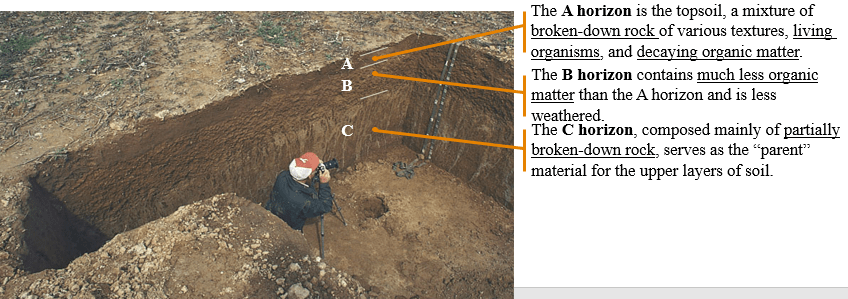
Availability of Soil Water
After a rainfall, water drains away from the larger spaces of soil but smaller spaces retain water because of its attraction to surfaces of clay and other particles.
The film of loosely bound water is usually available to plants
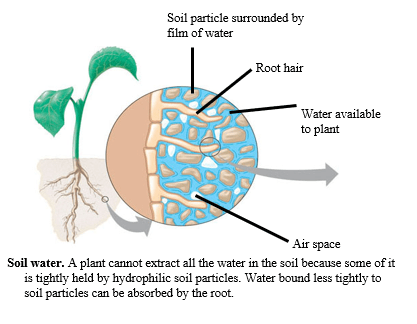
Cation Exchange:
Acids derived from roots contribute to a plant’s uptake of minerals when H+ displaces mineral cations from clay particles
Soils particles are generally negatively charged and so bind
positively charged nutrient ions (cations).
Cation Exchange Capacity refers to a soil’s ability to bind cations.
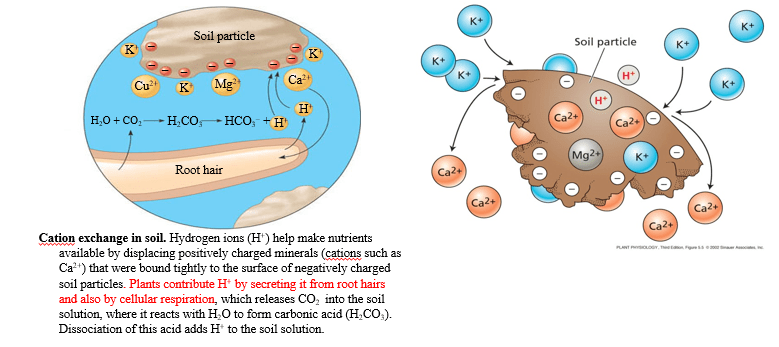
Soil pH influences availability of soil nutrients.

Adjusting soil pH to a recommended value can increase the availability of important nutrients. Plants usually grow well at pH values above 5.5. Soil pH of 6.5 is usually considered optimum for nutrient availability. Lower pH increases the solubility of Al, Mn, and Fe, which are toxic to plants in excess.
3. Concept of critical concentration illustrated
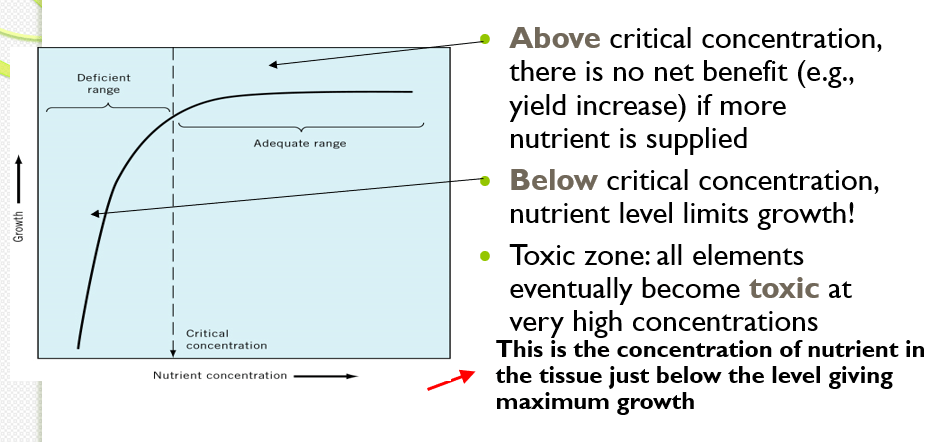
Analysis of plant tissues reveals mineral deficiencies:
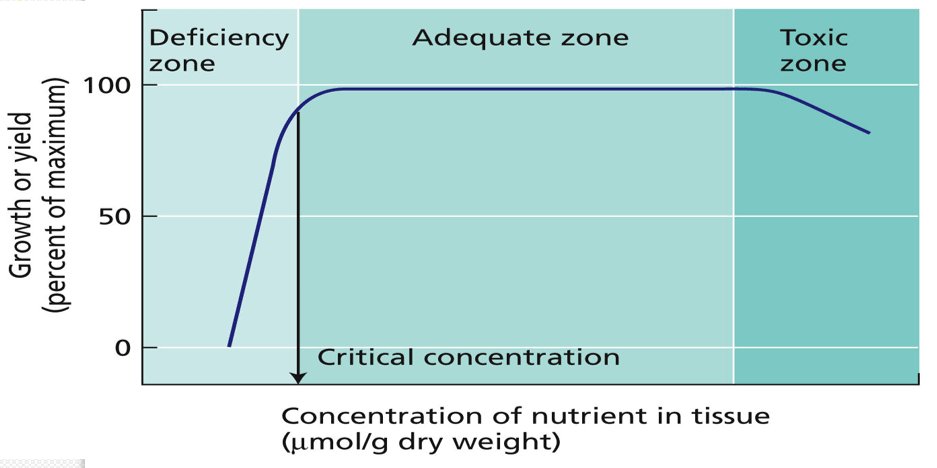
4. The role of function & mobility of the element in the development of mineral deficiency symptoms
The absence of essential elements causes deficiency symptoms:
Essential because of their metabolic functions 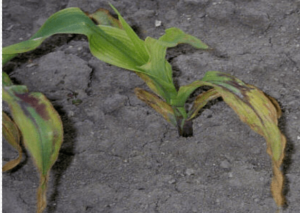
Characteristic deficiency symptoms shown because of these roles
Typical deficiency responses are
◦Chlorosis: yellowing; precursor to
◦Necrosis: tissue death
Expressed when a supply of an essential metabolite becomes limiting in the environment
Element concentrations are limiting for growth when they are below the critical concentration
Limiting nutrient levels negatively affect growth:
Plant responses to limiting nutrients usually very visible: affects yield/growth!
Again, chlorosis and necrosis of leaves is typical 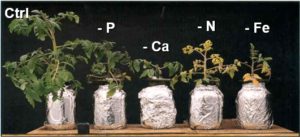
Sometimes straightforward relationship
◦e.g., in chlorosis (lack of green color),
N: chlorophyll component
Mg: cofactor in chlorophyll synthesis
(N & Mg deficiency also leads to chlorosis)
The symptoms of a mineral deficiency depend on the Function of the element
The symptoms of a mineral deficiency depend partly on the function of that nutrient in the plant.
◦For example, a magnesium deficiency, an ingredient of chlorophyll, causes yellowing of the leaves, or chlorosis.
The relationship between a mineral deficiency and its symptoms can be less direct.
◦For example, chlorosis can also be caused by iron deficiency because iron is a required cofactor in chlorophyll synthesis.
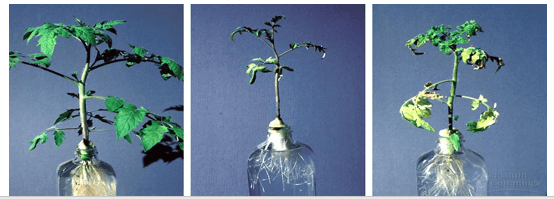
The symptoms of a mineral deficiency depend on the Mobility of the element
Mineral deficiency symptoms depend also on the mobility of the nutrient within the plant.
◦If a nutrient moves about freely from one part of a plant to another (mobile), then symptoms of the deficiency will appear first in older organs.
Young, growing tissues have more “drawing power” than old tissues for nutrients in short supply.
For example, a shortage of magnesium will lead to chlorosis first in older leaves.
◦If a nutrient is relatively immobile, then a deficiency will affect young parts of the plant first.
Older tissue may have adequate supplies which they retain during periods of shortage.
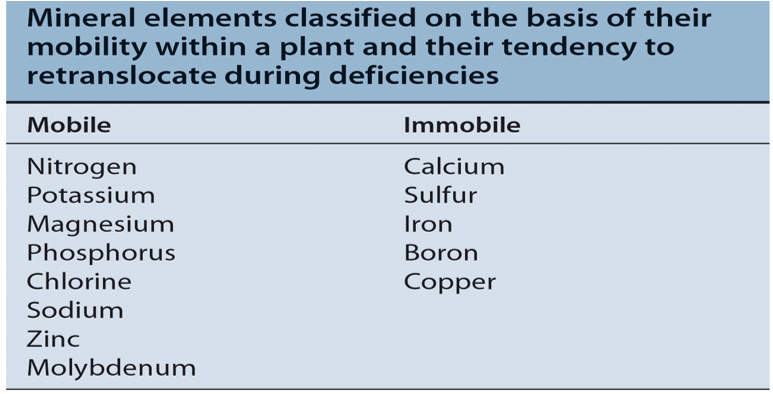
Analyzing Mineral Nutrition:
The symptoms of a mineral deficiency are often distinctive enough for a plant physiologist or farmer to diagnose its cause.
qThis can be confirmed by analyzing the mineral content of the plant and the soil.
◦Deficiencies of nitrogen (N), potassium (K), and phosphorus (P) are the most common problems.
◦Shortages of micronutrients are less common and tend to be geographically localized because of differences in soil composition.
The amount of micronutrient needed to correct a deficiency is usually quite small, but an overdose can be toxic to plants.
qThe other way to ensure optimal mineral nutrition is to grow plants hydroponically on nutrient solutions that can be precisely regulated.
◦This technique is practiced commercially, but the requirements for labor and equipment make it relatively expensive compared with growing crops in soil.
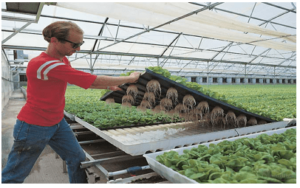
- Macronutrients: Functions; Deficiency & Toxicity Symptoms:
Macronutrients
a. Nitrogen (N)
*Nitrogen is one of the most important nutrients for crop growth and reproduction and is the mineral that has the greatest effect on plant growth thus the supply of useable nitrogen and the rate of losses from the soil affects the sustainability of production.
*Nitrogen is a component of chlorophyll and therefore essential for photosynthesis.
*Nitrogen is part of ATP (Adenosine)
*Plants require nitrogen as a component of proteins, genetic material (DNA, RNA), and a host of other important organic molecules
1) Soil Nitrogen Cycle
a)Nitrogen Fixation
-Transformation of atmospheric N to nitrogen forms available to plants
– Mediated by N-fixing bacteria:
Rhizobium (symbiotic) found in legumes (bean, soybean) Azotobacter (non-symbiotic bacteria)
b) Soil Nitrification
– Decomposition of organic matter into ammonium and nitrate
– Mediated by ammonifying and nitrifying bacteria
Ammonifying bacteria Nitrifying bacteria
(Azotobacter) (Nitrosomonas) (Nitrobacter)
Plant residue → NH4+ → NO2 → NO3–
(Protein, aa, etc) Ammonium Nitrite Nitrate
Soil Bacteria and Nitrogen Availability:
Nitrogen-fixing bacteria convert atmospheric N2 to nitrogenous minerals that plants can absorb as a nitrogen source for organic synthesis
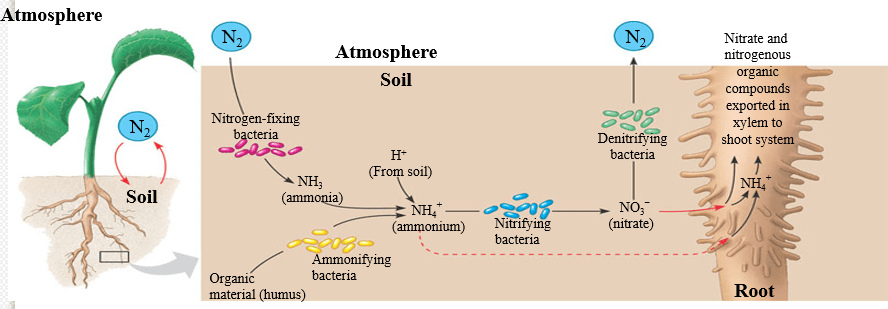
The Role of Bacteria in Symbiotic Nitrogen Fixation:
Symbiotic relationships with nitrogen-fixing bacteria provide some plant species with a built-in source of fixed nitrogen
From an agricultural standpoint the most important and efficient symbioses between plants and nitrogen-fixing bacteria occur in the legume family (peas, beans, and other similar plants)
Root Nodules:
Along a legumes roots are swellings called nodules composed of plant cells that have been
“infected” by nitrogen-fixing Rhizobium bacteria 
The bacteria of a nodule obtain sugar from the plant and
supply the plant with fixed nitrogen
Each legume is associated with a particular strain of Rhizobium
Development of a soybean root nodule:
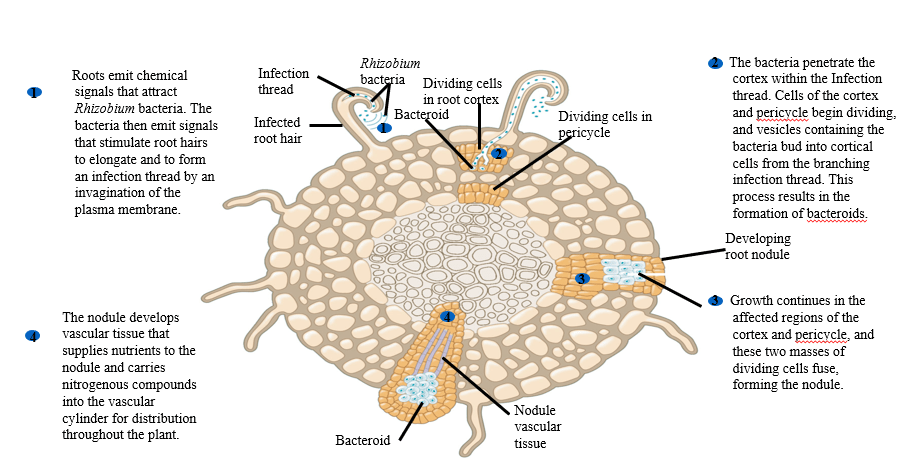
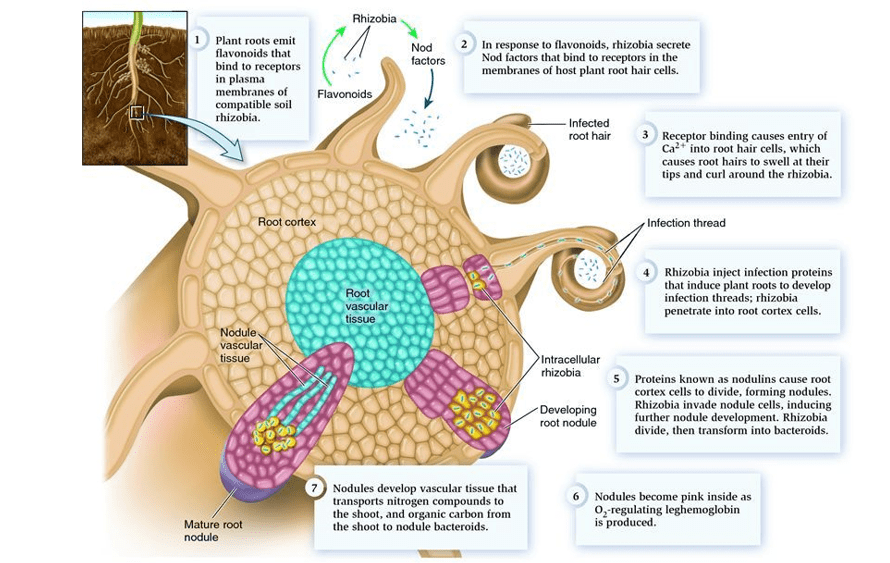
Symbiotic Nitrogen Fixation and Agriculture plants:
The agriculture benefits of symbiotic nitrogen fixation are the basis for crop rotation
In this practice a non-legume such as maize is planted one year, and the following year a legume is planted to restore the concentration of nitrogen in the soil
2) Deficiency and Toxicity Symptoms
Deficiency:
– Reduced/stunted growth
– Yellowing of old leaves
– burning of tips and margins of leaves starting at the bottom of the plant
Toxicity (excess): – Shoot elongation
– Dark leaves, succulence
4) Fertilizers
– Ammonium nitrate (NH4NO3)
Calcium nitrate [Ca(NO3)2]
Potassium nitrate (KNO3)
Urea [CO(NH2)2]
– Most plants prefer 50:50 NH4+ : NO3-
NH4+-form of N → lowers soil pH
NO3–form of N → raises soil pH
– Organic fertilizers (manure, plant residue) – slow acting
– N can be applied as foliar application
Nitrogen (N) Deficiency Symptoms:
